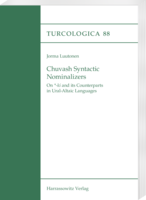|
weitere Titel zum Thema:
Download:
Chuvash has three morphemes, -i, -xi and -sker, which have intrigued scholars for over a century. To some extent, these suffixes resemble derivational endings that produce adjectives, but they also have properties that reach far beyond the sphere of lexical derivation. They are frequently attached to inflectional forms, e.g. case forms and participles, in which case they adopt the role of syntactic converters, changing the syntactic properties of the underlying form. For instance, a case form can be converted into an adjective-like entity, or a participle into a noun-like unit. Synchronically, the basic function of these Chuvash suffixes can be defined as syntactic nominalization.
Chuvash Syntactic Nominalizers by Jorma Luutonen contains a critical survey of the earlier research on the subject as well as text-corpus-based quantitative and qualitative analyses of the distribution and functions of the suffixes -i, -xi and -sker in Modern Chuvash literary language. All Chuvash examples are transliterated into Latin characters and provided with morphological glosses. In the historical-comparative part of the book, it is argued that -xi, and partly also -i, can be traced back to the Proto-Turkic *-ki, whose successors are frequently used in the Common Turkic languages, e.g. the Turkish -ki. The book includes separate chapters on Turkish and Tatar, and it also discusses the etymology of *-ki. A survey of the functional counterparts of the Chuvash suffixes in the Mongolic, Tungusic and Uralic languages, as well as in Russian, enables typological and areal linguistic generalizations to be made about the phenomenon. |






